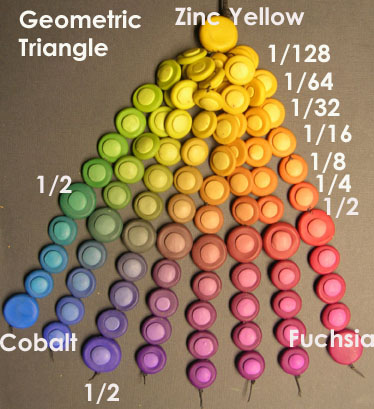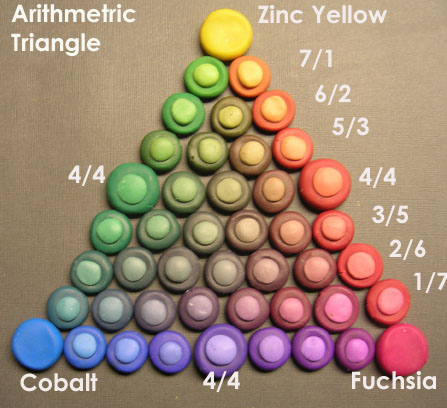 The best way to show the full gamut or range of colors that can be mixed from three primaries is with a triangle and, just like the color scales, there are two variations of color triangles; arithmetric and geometric.
The best way to show the full gamut or range of colors that can be mixed from three primaries is with a triangle and, just like the color scales, there are two variations of color triangles; arithmetric and geometric.
Mathematical vs Visual Balance
Arithmetric Triangles put the 1/2:1/2 mixes (in the sample they are labeled 4/4) in the middle position because they want to balance the numbers on both sides. But since primaries are never balanced in value or tinting strength this leads to triangles leaning toward one of the corners as the strongest of the darker colors takes over.
Notice that in the Premo sample above Cobalt is the bully color.
 On the other hand, Geometric Triangles allow you to put the 1/2:1/2 mixes in positions that are more visually balanced. You can compensate for both value and tinting strength variations in the primaries. This is what I mean when I say “Half and Half is NOT Halfway.”
On the other hand, Geometric Triangles allow you to put the 1/2:1/2 mixes in positions that are more visually balanced. You can compensate for both value and tinting strength variations in the primaries. This is what I mean when I say “Half and Half is NOT Halfway.”
Value Variations
If you have been doing color scales you have probably noticed how only a small part of blue mixed with yellow changes the yellow to a yellow green. Small color shifts show up more in lighter colors than in darker colors.
Darker colors will always pull the mix in their direction. Since yellow is a much higher value than the other primaries there are usually more steps on the yellow side of a 1/2:1/2 mix.
Tinting Strength Variations
You can’t always tell which color is stronger by just looking at it. Its not always the darkest color that is the stongest. In Premo, Ultramarine is darker but not as strong as Cobalt. Cobalt has a much higher tinting strength.
Even when colors are the same value, one of the colors will usually be stronger than the other and pull the mix in that direction. In the Premo sample shown, Cobalt has more tinting strength than Fuchsia. There are more steps included on the Fuschia side of the 1/2:1/2 mix in order to create visual balance.
Trichromatic Mixing
Both triangles are samples of trichromatic mixing. The traditional theory goes something like this; if you pick the right red, yellow and blue, you can mix all the colors of the rainbow, and they will all be harmonious because they come from the same primaries.
Smash, smash and smash.
We will get into all the reasons why trichromatic theory doesn’t work later. For now, I want to emphasize why it is helpful to practice mixing color this way.
Discovering the Beauty of Earth Colors
If you have ever taken one of my workshops then you know that I love tertiary colors. In modern color books the term “tertiary” is usually used to describe the colors between primaries and secondaries. In classic color books, tertiaries are colors that come from the mixing of secondaries – which means that they are colors with all three primaries in some proportion. I prefer the old definition.
The presence of a third primary in a mix will alway muddy the color. Its these tertiary, muddy, or earth colors that I love. And its these tertiary, muddy, or earth colors that show up in the middle of the triangles.
Which leads me to the main reason I like to play with trichromatic mixing. Its a great way to learn how to make gorgeous earth colors.
___________________________
This is a preview. A teaser. I am working on the next few Tutorials with instructions for making both Arithmetric and Geometric Triangles but they are taking me longer than I thought. Some of you will probably play around with making them right away. Cool! Let me know how they come out.


February 2, 2008 at 5:17 pm
My mum used to do this for her pottery glazes, this is amazing, you get great colours! This is fascinating…
France, who can’t even work a color wheel 😉